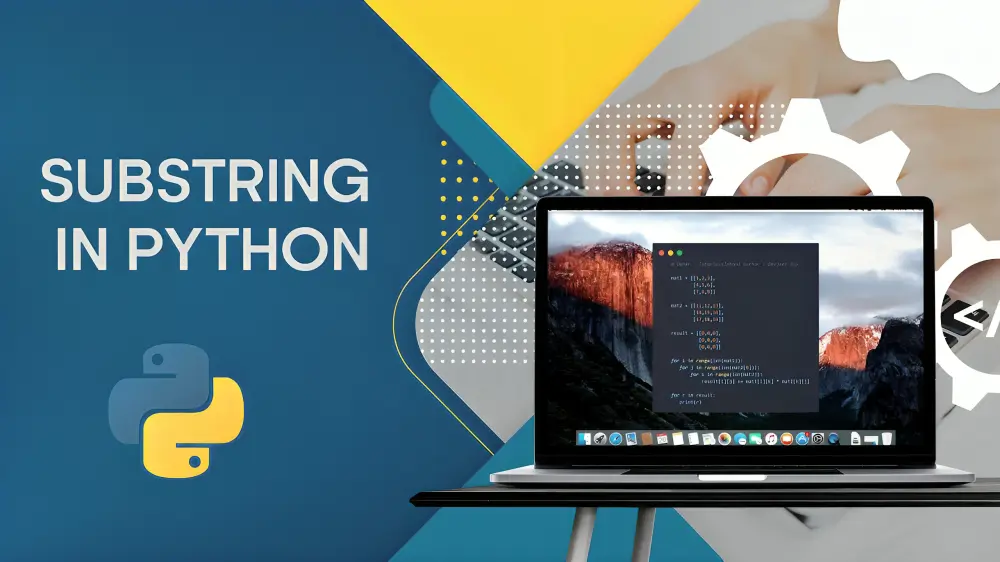Python is a robust and adaptable programming language that is used in a variety of contexts. Working with strings is one of the most common Python tasks, and understanding how to manipulate substrings is critical. This tutorial will walk you through the fundamentals of substring in Python, using concise explanations and examples.
What is a Substring in Python?
A substring is a segment of a string. Python provides several ways to create Substring in Python and methods to find out if a substring is in a string, find a substring’s index, and more. Let’s examine some substring-related operations.
Check Python Substring in String using the If-Else
An if-else statement in Python can be used to determine whether a Python substring is present in a string. Using the if-else statement, you can conditionally run distinct code blocks depending on whether the condition is true or false.
# Take input from users
MyString1 = “A geek in need is a geek indeed”
if “need” in MyString1:
print(“Yes! it is present in the string”)
else:
print(“No! it is not present”)
Checking Python Substring in String using Split() method
Using split(), determine whether the Python substring in the string is present. Using an if statement, determine whether a substring is present in the given string by first splitting it into words and storing them in a variable.
# input strings str1 and substr
string = “geeks for geeks” # or string=input() -> taking input from the user
substring = “geeks” # or substring=input()
# splitting words in a given string
s = string.split()
# checking condition
# If the supplied string contains a substring, the output is yes
if substring in s:
print(“yes”)
else:
print(“no”)
Using the In Operator to Check a Python Substring in a String
The in-operator in Python makes it simple to determine whether a substring exists in a given string. To determine whether a specific value (substring) exists within a sequence, use the in operator.
text = “Geeks welcome to the Geek Kingdom!”
if “Geek” in text:
print(“Substring found!”)
else:
print(“Substring not found!”)
if “For” in text:
print(“Substring found!”)
else:
print(“Substring not found!”)
Check Python Substring in String using the Find() method
Although we could check each word one at a time, Python has a built-in function called find() that does this in a single line by determining whether a substring is present in the string. This problem can be resolved by using the find() function, which returns -1 if it cannot be found and returns the first occurrence otherwise.
def check(string, sub_str):
if (string.find(sub_str) == -1):
print(“NO”)
else:
print(“YES”)
# driver code
string = “geeks for geeks”
sub_str = “geek”
check(string, sub_str)
Check Python Substring in String using List Comprehension
To use list comprehension to validate a Python substring in a string. List comprehension is a simple method for finding a substring in a string and seeing if it appears in any of the words.
s=”geeks for geeks”
s2=”geeks”
print([“yes” if s2 in s else “no”])
Check Python Substring in String using Slicing
Use slicing to check the Python substring in the string. This implementation compares the current substring to the substring argument using slicing after iterating through each possible starting index of the substring in the string using a loop. The function returns True if the current substring matches the substring argument; if not, it returns False.
def is_substring(string, substring):
for i in range(len(string) – len(substring) + 1):
if string[i:i+len(substring)] == substring:
return True
return False
string = “A geeks in need is a geek indeed”
substring = “geeks”
print(is_substring(string,substring))
Conclusion
For efficient string manipulation in Python, one must comprehend Substring in Python. This guide offers concise explanations and useful examples for a variety of substring identification and extraction techniques, including list comprehension, slicing, the if-else statement, the split() method, the in-aerator, and the find() function. Gaining proficiency with these methods improves your Python programming abilities.





